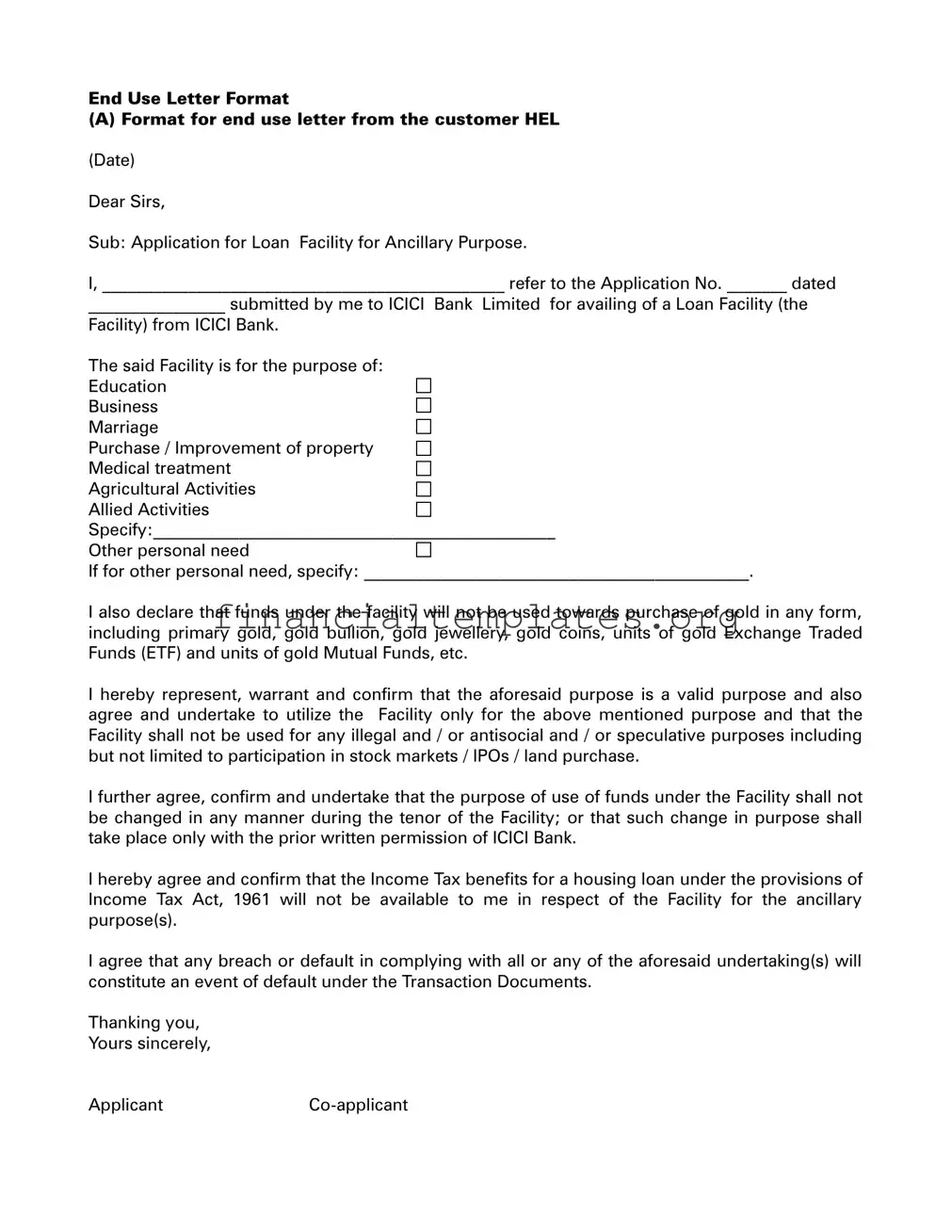A Personal Loan Agreement is quite similar to the Loan End Use Letter Format, as both documents outline the terms and conditions under which a loan is provided. The Personal Loan Agreement, however, goes into more detail regarding repayment terms, interest rates, and the consequences of non-repayment. Both documents ensure there's a clear understanding between the lender and borrower about how the loan will be used and the obligations involved.
A Mortgage Agreement shares common elements with the Loan End Use Letter Format, mainly in specifying the purpose of the loan. While the Loan End Use Letter Format can cover various purposes like education or business needs, a Mortgage Agreement is specifically for the purchase or improvement of property. Both documents include clauses to ensure the borrower does not use the funds for illegal or unspecified purposes.
The Business Loan Agreement, similar to the Loan End Use Letter Format, outlines the specifics of a loan taken for business purposes. Both documents include details about the loan amount, purpose, and restrictions on fund usage. However, Business Loan Agreements typically also detail collateral requirements, financial covenants, and conditions precedent to the funding of the loan.
An Education Loan Agreement and the Loan End Use Letter Format are similar in that they are both used for specifying the purpose of the loan related to education. However, the Education Loan Agreement will often have more detailed sections on repayment schedules, grace periods, and the specifics of how the funds can be applied towards education expenses.
A Debt Settlement Agreement differs from the Loan End Use Letter Format in purpose but is similar in its formal arrangement between two parties. While the Loan End Use Letter outlines how a borrower plans to use the loan funds, a Debt Settlement Agreement comes into play when negotiating the repayment of existing debt under new terms. Both documents formalize the intentions and agreements of the parties involved to prevent misunderstandings.
The Promissory Note, while typically shorter and less detailed, serves a purpose similar to that of the Loan End Use Letter Format by documenting a promise to pay. However, it focuses more on the repayment of the loan rather than the specifics of its use. The clarity and binding commitment in both documents serve to protect the interests of the lender and borrower.
A Credit Agreement shares similarities with the Loan End Use Letter Format in that it is a formal document between a lender and borrower outlining the terms of a loan. Credit Agreements tend to be more comprehensive, covering a broad range of terms such as interest rates, repayment terms, and covenants, beyond just the usage of the loan funds.
An Investment Agreement, although generally used for equity transactions, shares the formal structure and purpose specification with the Loan End Use Letter Format. Both document the intent of the funds – the Investment Agreement for an equity stake in a business, and the Loan End Use Letter for specific personal or business needs.
The Lease Agreement, while primarily used for the rental of property, resembles the Loan End Use Letter Format in its structure of stating terms and conditions agreed upon by two parties. Both define the use of property or funds, conditions, and restrictions, ensuring both parties adhere to agreed-upon terms.
Last, a Cosigner Agreement is analogous to the Loan End Use Letter Format in situations where a cosigner is involved in a loan. It outlines the responsibilities of the cosigner should the primary borrower fail to repay the loan. Although focusing more on repayment, it shares the element of formalizing an agreement to safeguard the involved parties' interests.


